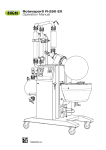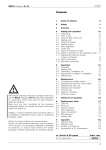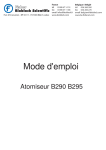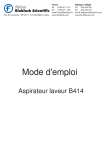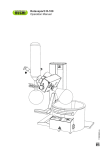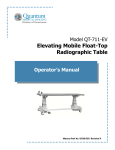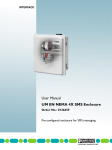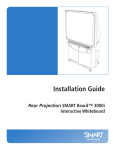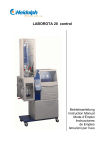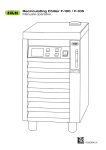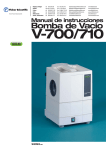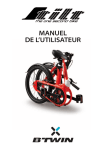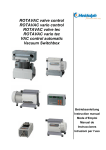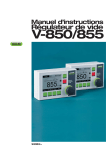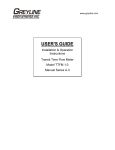Download Operation Manual
Transcript
BÜCHI Rotavapor R-220 Table of Contents Table of Contents 1 Scope of Delivery 2 2 Safety 3 3 Function 3.1 Principle of Operation 4 4.1 4.2 4.3 4.4 4.5 4.6 4.7 4.8 4.9 4.10 4.11 4.12 4.13 4.14 4.15 4.16 Putting into Operation Installation Location Unpacking Setting up the Support Rod Attachment of the EasyClamp Removal of the EasyClamp Installation of the Reflux Glass Assembly Installation of the Descending Glass Assembly Installation of the Descending Glass Assembly with a 2nd Cooler Installation of the Receiving Fixture Attaching and Removing Flasks Hose Coupling Operating the Shut-off tap Bath Replenishment (Optional) Reset of the over-temperature protection Heating Medium Checking Installation 5 Operation 5.1 Arrangement of the Operator Control and Display Elements 5.2 Adjusting the Maximum Set-Point Temperature and Automatic Lowering of the Bath in Case of a Power Interruption 5.3 Tips and Tricks 5.4 Table of Solvents 6 6 7 7 7 8 9 9 10 11 12 13 14 16 18 18 19 19 19 20 6 6.1 6.2 6.3 6.4 6.5 6.6 6.7 6.8 6.9 6.10 Maintenance Taking Apart the Snap Flange Coupling Assembling the Snap Flange Coupling Removing the Evaporating Flask Seal Inserting the Evaporating Flask Seal Replacement of the Seals for the Distribution Head Replacement of the Vacuum Seal Cleaning Vacuum Seal Testing for Leaks Customer Service 23 23 24 24 25 25 26 26 26 27 27 7 Taking out of Operation 28 8 8.1 8.2 8.3 8.4 Spare Parts and Accessories Glass Assemblies D, D2, DB, DB2 Glass Assemblies R, RB, C Miscellaneous Accessories 9 9.1 9.2 9.3 9.4 9.5 Appendix Technical Data Materials Used Error Messages FCC requirements (for USA and Canada) Declaration of Conformity 29 30/31 32/33 34 37 42 42 42 43 44 45 20 20 21 22 Read this Operating Manual through carefully before using the Büchi Rotavapor R-220. Always keep these Instructions readily available in the immediate vicinity of the unit so that they make be consulted at any time. Chapter 2 contains important safety rules which must be observed to ensure the safe operation of the rotary evaporator. We reserve the right to make technical changes without prior notification. No portion of this Operating Manual may be reproduced, processed using electronic or optical systems, duplicated, or distributed in any form without the prior written approval of Büchi Labortechnik AG. All rights reserved. © Büchi Labortechnik AG, 1999-2001 en, Version G (46 Pages) R-220 Operation Manual Ordering No. 96737 1 BÜCHI Rotavapor R-220 1 Scope of Delivery 1 Scope of Delivery Component 1 Chassis, complete, with control and driving unit and with heating bath 1 6L, 10L or 20L Evaporation flask 1 Receiving flask 1 x 10L Single receiver or 2 x 10L Interchangeable receivers 1 Glass assembly (Refer to Chap. 4.6 - 4.8 for Figure) Table 1: Scope of Supply Standard Accessories: 1 Seal tool Ordering No. 20057 1 Operating Manual German 96736 English 96737 French 96738 Italian 96739 Spanish 96740 Table 2: Standard Accessories Fig. 1: R-220, Overall View 2 BÜCHI Rotavapor R-220 2 Safety 2 Safety This unit has been built in accordance with the latest state of the art and with recognized rules of safety. Nevertheless there are certain risks and dangers entailed with this unit: • whenever the unit is operated by individuals who lack sufficient training; • whenever the unit is used for some purpose other than its authorized use. 2.1 Symbols Stop Information on dangers that can cause serious material damage and severe personal injuries or death. Warning Information on dangers that can be injurious to one’s health or cause material damage. Note Information pointing out technical requirements. A failure to observe such information can lead to malfunctions, uneconomical operation, and losses in production. 2.2 Responsibilities of the Operator This unit may only be used by technical staff and by individuals who, based on their training or their professional experience, have a good understanding of the dangers that can arise from the its operation. Staff who do not have this training and individuals who are currently in training must be given careful instructions. This Operating Manual should be used as the basis for such training. 2.3 Authorized Use The rotary evaporator has been designed for use in technical laboratories and in production. It is authorized for use in applications that work with the evaporation and condensation of solvents. It is used for: • Evaporation of solvents and suspensions • Drying of powders and granulates • Re-crystallization • Reactions under reflux • Synthesis and Cleaning of refined chemicals • Recycling and concentration of solvents The authorized use of the Rotavapor also includes its care, upkeep, and careful handling in accordance with the provisions in this Operating Manual. 3 BÜCHI Rotavapor R-220 2 Safety 2.4 Unauthorized Use Any use other than those indicated above, and any use that is not in conformity with the Technical Data is considered to be misuse. The operator himself bears sole responsibility for all damage or injuries arising from any such use. The following applications in particular are strictly forbidden: • The production and processing of materials that can cause spontaneous reactions, e.g., explosives; • Working without the evaporation flask being immersed in the water bath (risk of breakage); • The drying of hard, brittle materials (e.g., stones, soil samples) that might cause damage to the receiving flask; • Sudden shock-cooling of the evaporating flask. The Rotavapor R-220 is not intended for work done under overpressures. 2.5 Basic Dangers Basic dangers arise when working with the following: • The hot water or oil bath (risk of being scalded); • Contaminated solvents that produce residues from distillation which could cause spontaneous reactions (e.g., metal hydrides); • Solvents that can produce peroxides (risk of explosions); • Mixtures with unknown compositions or contamination; • Damaged glassware; • Electrostatic charges while working, e.g., during the transfer of combustible solutions and while drying powders; • Temperatures of coolants that lie below the freezing point of the distillate (A clogging of the distillate cooler due to freezing out can result in too great an overpressure). 2.6 Safety Precautions All regional and local laws and regulations must be observed. The Rotavapor has been grounded internally to dissipate any electrostatic charges on it. 4 BÜCHI Rotavapor R-220 2 Safety It is always mandatory to wear personal protective gear such as protective eyewear and protective clothing. The machine must never be rotated without the snap flange coupling and evaporation flask being closed. No distillation may be started unless the evaporating flask is immersed in the bath. There is always the risk that the neck of the flask might break off due to the great weight involved. There is a risk of becoming scalded while changing evaporating flasks. Wearing gloves prevents this. Check the glass components regularly for possible damage, spreading impact marks, or cracks. Never interrupt the grounding conductor (protective conductor). Otherwise there will be the risk of an electrical shock! The operator bears responsibility for providing proper instruction of his operating staff. To aid him in doing this, translations of this Operating Manual are also available in several other languages. As an integral component of the rotary evaporator, this Operating Manual must be readily available at all times to the operating staff at the location where they are using the unit. The operator must inform the manufacturer immediately of any and all events relevant to safety that occur in his use of this equipment. 2.7 Modifications No modifications are permissible without consulting with and obtaining the written approval of the manufacturer. No glass assemblies other than those recommended by the manufacturer may be used, nor may any glass components be put together arbitrarily. Only those components of the rotary evaporator intended for fulfillment of its function may be installed in or removed from the unit. This may be done either by hand, or with the use of the tool supplied along with the unit. The removal of safety devices or covers using some commercially available tool is — other than for authorized commissioning personnel — strictly forbidden. Contact with parts that are electrically live may result in fatal injury! 5 BÜCHI Rotavapor R-220 3 Function 3 Function A vacuum rotary evaporator is used for quick single-stage distillations that treat the product gently. The process is based on the evaporation and condensation of solvents in a rotating evaporating flask. It is possible to work under a vacuum to ensure gentler treatment of the product and increase productive output. Distillation may be done either under a vacuum or at atmospheric pressure. A secure closeness is guaranteed in the low pressure range. 3.1 햶 햲 Evaporation Zone The solvent in the evaporating flask is heated by the heating bath. The rotation of the evaporating flask ensures an intensive exchange of heat and mass within the contents of the flask, forming a thin film of solvent on the inner surface of the flask. This combination of turbulence and film prevents local overheating and ensures high distillation speed. 햳 햳 Rotary Drive The drive unit ensure the uniform rotation of the evaporating flask. 햴 햲 햵 Principle of Operation 햴 Cooling Zone The solvent vapor flows into the cooler at a high speed. This is where the energy in the solvent vapor is transferred to the cooling medium (e.g., water). The solvent condenses. 햵 Receiving Flask The receiving flask is used to collect the condensate. 햶 Vacuum Cover The system pressure is reduced so as to lower the boiling point of the solvent. The reduction in thermal loading that results ensures gentle treatment of the product and offers energetic advantages. Fig. 2: Principle of operation of the R-220 The pressure (vacuum) of distillation, the temperature of the heating bath, the rotational speed, and the size of the evaporating flask all affect the evaporation output. Refer to Chapter 5.3 for how to select the optimum conditions of distillation. 6 BÜCHI Rotavapor R-220 4 Putting into Operation 4 Putting into Operation The danger zone around the Rotavapor R-220 can extend outward by up to 10 m. When working inside this danger zone, there is a risk of damaging the glass parts, which could cause them to implode. The electrical connection must be installed and checked by an authorized person. 4.1 Installation Location Always set the unit up on a clean, stable, and flat surface. Never at a location where there is a great deal of personal traffic (breaking or broken glass) ! The dimensions of the rotary evaporator are: Height: without trolley with trolley Reflux Descending Bullfrog Reflux Bullfrog Descending 1700 mm 1800 mm 1430 mm 1550 mm Reflux Descending 2300 mm 2400 mm Width: Reflux 1100 mm Descending 1250 mm Descending, with 2 coolers 1250 mm Depth: Single receiver Interchangeable receivers 4.2 550 mm 650 mm Unpacking Take care not to break the glass when opening cartons that contain glassware. Look for any damage after unpacking. It is important that any damage in transit be identified right when unpacking. If necessary, make an immediate assessment of the situation (Notify the post office, the railroad, or the shipping company involved). Save the original packing for possible transport at a later date. 7 BÜCHI Rotavapor R-220 4 Putting into Operation 4.3 Setting up the Support Rod • Place the support rod 햳 into the holder provided for it and lower it into the foot hole at the back. Fix it tight using the locking screw 햲. • Put the positioning ring 햴 on over the rod, 150 mm below the upper edge. 햵 • Lay the pivoting clamp 햵 on top of the positioning ring. 햴 • Attach the pivoting clamp for the receiving flask 200 mm above the bottom edge of the rod. 햳 햲 When installing an interchangeable receiver: • Place the short support rod into the holder at the front and lower it into the foot hole. Screw it tight using the locking screw. • Attach the pivoting clamp approx. 200 mm above the lower edge of the rod. Fig. 3: Support rod 8 BÜCHI Rotavapor R-220 4 Putting into Operation 4.4 Attachment of the EasyClamp • Carefully lay the EasyClamp around the glass and fold the top and bottom segments together, closing them at their open connection point. • Insert the bolt that does not have a spacer spring, and tighten the knurled nuts slightly. • Tighten all knurled nuts uniformly by hand. Note: Always tighten the knurled nuts by hand and not to the block (with the spring pressed together completely). Otherwise the prestressing will be lost. There must always be a gap of about 2 mm between the knurled nut and the support surface. Fig. 4: Attachment of the EasyClamp 4.5 Removal of the EasyClamp On all EasyClamp connections, only the bolt without a spacer spring has to be removed in order to open the connection. • Release the knurled nuts on all (2 or 3) bolts until the springs have been relieved. Do not, however, screw the nut all the way off. • On the bolt that does not have a spacer spring, release the knurled nut far enough (without removing it completely) so that the bolt can be tilted out and removed as a unit. • At the connection point, which is now open, spread the top and bottom segments apart and carefully remove the EasyClamp. Fig. 5: Removal of the EasyClamp 9 BÜCHI Rotavapor R-220 4 Putting into Operation 4.6 Installation of the Reflux Glass Assembly All glassware used must be intact, with no signs of cracks, spreading impact marks, or other damage. Inspect the glassware visually before installing it. • Fix the reflux distribution head 햲 in position on the gear head using a DN70 EasyClamp connection. 햶 • Introduce the cooler 햳, together with the cooler holder 햴, into the pivoting clamp 햵 and connect it to the distribution head (DN45 EasyClamp connection). • Align the cooler 햳 in a vertical position and fix it in place with the pivoting clamp 햵. 햴 • Screw the cooling water hose nipples 햶 onto the cooler 햳. • Insert the shut-off tap 햷 into the distribution head 햲 and tighten it firmly. 햵 • Introduce the stop cock 햸 into the distribution head with the PTFE hose attached to it, and secure it with a standard joint clamp 햹. 햳 햶 햷 햹 햸 햲 햺 Fig. 6: Reflux glass assembly 10 햻 • Attach the condensate cooler 햺 to the distributor head with a DN25 EasyClamp connection and fix it in position. • Screw the temperature sensor 햻 into the distribution head 햲. • Check all EasyClamp connections and tighten them evenly and in parallel. → The installation of the receiving fixture is described on Page 13. BÜCHI Rotavapor R-220 4 Putting into Operation 4.7 Installation of the Descending Glass Assembly All glassware used must be intact, with no signs of cracks, spreading impact marks, or other damage. Inspect the glassware visually before installing it. • Fix the descending distributor head 햲 in position on the gear head using a DN70 EasyClamp connection. 햾 햷 햸 • Put the expansion vessel 햳 onto the distribution head and fix it in position with a DN45 EasyClamp connection. • Introduce the cooler 햴, together with the cooler holder 햵, into the pivoting clamp 햶 and connect it to the distribution head (DN45 EasyClamp connection). • Connect to the cooler and the expansion vessel using the U-tube 햷 and fix in position with two DN45 EasyClamp connections. 햴 • Align the cooler 햴 and the expansion vessel 햳 in their vertical positions and fix them in place with a pivoting clamp 햶. 햷 햶 햳 • Screw the cooling water hose nipples 햸 onto the cooler 햴. • Insert the stop cock 햹, with the PTFE hose mounted on it, into the distribution head, and secure it with a standard joint clamp 햺. 햸 • Fasten the vacuum connector 햻 to the Y-connection 햽 with a DN45 EasyClamp connection and fix the unit in place on the lower end of the cooler with a DN45 EasyClamp. 햻 햲 햽 햺햹 Fig. 7: Downgrade glass assembly • Screw the temperature sensor 햾 into the support connection in the U-tube 햷. • Check all EasyClamp connections and tighten them evenly and in parallel. → The installation of the receiving fixture is described on Page 13. 11 BÜCHI Rotavapor R-220 4 Putting into Operation 4.8 Installation of the Descending Glass Assembly with a 2nd Cooler All glassware used must be intact, with no signs of cracks, spreading impact marks, or other damage. Inspect the glassware visually before installing it. • Fix the descending distributor head 햲 in position on the gear head using a DN70 EasyClamp connection. 헀 햷 햴 • Place the expansion vessel 햳 on the distribution head and fix it in position with a DN45 EasyClamp connection. • Introduce the cooler 햴, together with the cooler holder 햵, into the pivoting clamp 햶. 햽 • Connect the cooler and the expansion vessel with the Utube 햷 and fix them in position with two DN45 EasyClamp connections. 햺 햹 • Insert the second cooler 햸, together with the cooler holder 햹, into the pivoting clamp 햺. 햶 햵 햸 햳 햲 햽 • Join the two coolers with the Y-connection 햻 and fix them in position with two DN45 EasyClamp connections. • Align the coolers (햴 and 햸) and the expansion vessel 햳 in their vertical positions and fix them in place with pivoting clamps (햶 and 햺). • Screw the cooling water hose nipples 햽 onto coolers 햴 and 햸. • Insert the stop cock 햾, with the PTFE hose mounted on it, into the distribution head, and secure it with a standard joint clamp 햿. 햻 햿 햾 Fig. 8: Downgrade glass assembly with two coolers • Screw the temperature sensor 헀 into the support connection in the U-tube. • Check all EasyClamp connections and tighten them evenly and in parallel. → The installation of the receiving fixture is described on Page 13. 12 BÜCHI Rotavapor R-220 4 Putting into Operation 4.9 Installation of the Receiving Fixture All glassware used must be intact, with no signs of cracks, spreading impact marks, or other damage. Inspect the glassware visually before installing it. Single Receiver 햷 햶 햵 햲 햴 햳 Fig. 9: Single receiver, reflux • Fasten the support ring 햲 to the support rod with a pivoting clamp 햳. • Screw the outlet valves 햴 on the receiving flask 햵 on tight using a DN25 EasyClamp connection. • Place the receiving flask on the support ring 햲. With a reflux glass assembly: • Bring the support up and fix the flask in position on the distillate cooler using a DN25 EasyClamp connection. 햵 햲 햴 햳 Fig.10: Single receiver, downgrade With a descending glass assembly: • Attach the branching piece 햶 to the opening at the bottom of the Y-connection with a DN45 EasyClamp connection. • Insert the shut-off tap 햷 into the branching piece 햶 and tighten it firmly. • Bring the support up and fix the receiving flask 햵 in position on the branching piece 햶 using a DN25 EasyClamp connection. Dual Receiver • Fasten the support rings 햲 to the support rods at the front and back using pivoting clamps 햳. • Screw the outlet valves 햴 firmly onto the receiving flask 햵 using DN25 EasyClamp connections. • Place the receiving flasks 햵 on the support rings 햲. • Screw the two shut-off taps 햶 into the branching pieces (햷 and 햸) and tighten them. • Connect the branching pieces with a DN25 EasyClamp connection. Place them on the receiving flasks 햵, and fasten them with DN25 EasyClamp connections. 햶 햶 햸 햷 햵 햲 햲 햳 햴 햳 햴 With a reflux glass assembly: • Bring the receiving flask up, and fasten the branching piece 햸 to the condensate cooler using a DN25 EasyClamp connection. With a descending glass assembly: • Bring the receiving flask up, and fasten the branching piece 햸 to the Y-connection using a DN25 EasyClamp connection. Fig. 11: Interchangeable receiver 13 BÜCHI Rotavapor R-220 4 Putting into Operation 4.10 Attaching and Removing Flasks Bring up the flask • With the snap flange coupling open, lay the flask in position. • Close the first segment of the snap flange coupling( T h e hook must latch in). Fig. 12: Snap flange coupling, with flask laid in place • Close the second segment of the snap flange coupling. • Insert the closure hook and press down the closure lever. A clear resistance must be felt when this is done. If not, readjust the tension on the closure. Fig. 13: Closing the snap flange coupling Adjusting the tension on the closure: Open the closure hook up, and turn it. Turning clockwise Turning counterclockwise increases pressure reduces pressure If the flange of the evaporating flask is outside of a certain tolerance, the adjustment with the hook is not possible. This evaporating flask must not be used! Fig. 14: Adjusting the tension on the closure 14 BÜCHI Rotavapor R-220 4 Putting into Operation Removing flasks • Place your hand under the flask to hold it from below. • Open the closure lever 햲. 햲 • Use your thumb to release the closure hook 햳. • Flip up the first segment of the snap flange coupling. 햳 Fig. 15: Opening the closure 햴 • With your hand under the flask, lift it lightly slightly from below and relieve pressure on it. • Press the hook 햴 in. • Open the second segment of the snap flange coupling. • Lift the flask out at the top and remove it. Fig. 16: Opening the second segment 15 4 Putting into Operation BÜCHI Rotavapor R-220 4.11 Hose Couplings In general, observe the following items for all glass assemblies. The cooling water inlet is always at the lower condenser connection. When there are two condensers (D2 und DB2), the two condensers can be connected serially, the additional condenser being cooled first. 햳 The following is the key for all of the hose diagrams on these two pages. 햲 햳 햴 햵 햶 햷 햸 햲 햶 햷 햳 햵 햴 햲 Fig. 17: Hose Couplings 1 16 Cooling water inlet for first condenser Cooling water outlet for first condenser Cooling water inlet for second condenser Cooling water outlet for second condenser Vacuum connection Vacuum controller T-piece (026117) BÜCHI Rotavapor R-220 4 Putting into Operation The following is the key for all of the hose diagrams on these two pages. 햵 햷 햵 햶 햲 햳 햴 햵 햶 햷 햸 Cooling water inlet for first condenser Cooling water outlet for first condenser Cooling water inlet for second condenser Cooling water outlet for second condenser Vacuum connection Vacuum controller T-piece (026117) 햴 햳 햲 햷 햷 햸 햶 햳 햲 Fig. 18: Hose Couplings 2 17 BÜCHI Rotavapor R-220 4 Putting into Operation 4.12 Operating the Shut-off tap The shut-off tap is of a special design. It does not have a continuous thread on its inside for tightening it, but rather a sliding plane with two fixed latching positions. The closing pressure when it is in a closed position is provided by a prestressed spring. 햳 햲 • Insert the shut-off tap on the distribution head and turn the white lower section of the grip 햲 clockwise until the shut-off tap is tightly seated. • To open: Turn the gray upper section of the grip 햳 clockwise until the shut-off tap latches into the 1st position. If the opening is not large enough, continue turning until the shut-off tap reaches the 2nd position. 햳 Fig. 19: Shut-off tap 4.13 Bath Replenishment (Optional) 햴 햲 Bath replenishment inlet Hose nipple, Diam.14 mm 햳 Bath replenishment outlet Hose nipple, Diam.14 mm Fig. 20: Bath replenishment 햲 Opening the needle valve 햴 slightly by one-quarter turn produces a continuous supply flow. 햳 Introduce the Open/Shut valve supplied with the unit into the bath replenishment inlet 햲 and connect it to “CW Valve” on the back wall of the unit. This interrupts the replenishment of the bath when rotation stops. The installation of the water valve is described in chapter 8, Replacement Parts, Water Valve. If oil is used as heating medium, the bath replenishment has to be emptied and disconnected from the water inlet. Otherwise, there is a risk of water pouring into the hot oil bath. Operating Instructions! When rotation stops, the cooling water and bath replenishment water switch OFF after short delay. As soon as rotation starts, the valve reopens and the water flows once again. Fig. 21: Bath replenishment 18 BÜCHI Rotavapor R-220 4 Putting into Operation 4.14 Reset of the over-temperature protection If the heater heats up over 205°C (e.g. if no heating medium is in the bath), it is cut off by a mechanical overtemperature protection.The overtemperature protection is reset by pushing the button under the heating block. Fig. 22: Reset of the over-temperature protection 4.15 Heating Medium Never operate the heating bath when there is no heating medium in it! Suitable heating media include: • Water (some Borax should be added when using deionized water) • Heat transfer oils suitable for use at temperatures up to 160° C (e.g., Ucon HTF 14, Fluka AG). • Water-soluble polyethylene glycol (e.g., Polyethylene glycol 600, Fluka AG). After the oil bath has been standing opened for a prolonged period, condensation water can collect on the bottom. When the bath is used again, it must be heated above 100°C with rotating flask in order to drive the water out. 4.16 Checking Installation After installation has been completed and before doing the first distillation, check to make sure the installation has been carried out correctly: • Inspect the glass visually for possible damage. • Check that all connections (steam, water, vacuum) have been fixed properly in position. • Check the tightness of the vacuum. 19 BÜCHI Rotavapor R-220 5 Operation 5 Operation Make certain that the unit has been commissioned properly as described in Chapter 4. 5.1 Arrangement of the Operator Control and Display Elements 햲 Main breaker switch 햳 Lift for the bath 햻 햴 Rotation ON/OFF 햺 햵 Rotating speed adjustment 햶 햶 Rotating speed display 햹 햷 Heater ON/OFF 햸 Input: Set-point temperature for bath 햵 햸 햹 Temperature UP/DOWN 햺 Display for bath temperature 햷 햴 햻 Display for vapour temperature 햽 Aeration 햽 햳 햲 The bath is lowered automatically when the unit is switched off or in case of a power failure to ensure that the evaporating flask will in all cases remain outside the source of heat (optional). Fig. 23: Operator control elements for the R-220 5.2 Adjusting the Maximum Set-Point Temperature and Automatic Lowering of the Bath in Case of a Power Interruption Setting the Maximum Set-Point Temperature • Press the button “SET TEMP” 햸, simultaneously switching on the main breaker switch 햲. This activates the input for setting the maximum set-point temperature. • The value can be set at any level desired by pressing the “DOWN” and “UP” buttons 햹. • The input is stored and the unit switched into the operating mode only after the “AERATE” button 햽 is then pressed. 20 BÜCHI Rotavapor R-220 5 Operation Adjusting the Optional Automatic Lowering of the Bath in Case of a Power Interruption • Press the button “LIFT down” 햳, simultaneously switching on the main breaker switch 햲. This results in the display “ON” or “OFF”. On = The lift lowering has been switched ON Off = The lift lowering has not been switched ON. • To switch back and forth between ON and OFF, press repeatedly on the button “LIFT down” 햳. • The input is stored and the unit switched into the operating mode only after the “AERATE” button 햽 is then pressed repeatedly. 5.3 Tips and Tricks Selection of the Distillation Temperature In order to attain optimum distillation conditions, the energy supplied to the distillation from the bath must be dissipated again across the cooler. In order to ensure this, it is best to work according to the following rule of thumb: Cooling water max. 20 ºC ∆T2 Boiling temperature 40 ºC ∆T1 Bath 60 ºC How do you attain these conditions? • Set the bath temperature at 60 ºC. • Adjust the cooling water. Its temperature should not be higher than 20 ºC. • Allow the cooling water to flow through the cooler at a rate of about 120–150 liters/hr. • Select the working vacuum so that the boiling point of the solvent is at 40 ºC. • Obtain the corresponding value for the vacuum from the Table of solvents. Advantages of a Bath Temperature of 60 °C • Evaporating flasks can be changed without any danger of scalding. • The rate of water evaporation out of the heating bath is not yet very high. • The energy in the heating bath is being utilized very efficiently. The solvent should condense out in approx. 2/3 to 3/4 of the lengths of the cooling coils present. 21 BÜCHI Rotavapor R-220 5 Operation 5.4 Solvent Formula Molar Mass in g/mol Evaporation Energy in J/g Table of Solvents Boiling Point Spec.Gravity at 1013 mbar in g/cm3 Vacuum in mbar for a Boiling Point at 40°C Acetic acid C2H4O2 60.0 695 118 1.049 44 Acetone C3 H6 O 58.1 553 56 0.790 556 n-Amyl alcohol, n-Pentanol C5H12O 88.1 595 37 0.814 11 Benzene C6H6 78.1 548 80 0.877 236 n-Butanol, tert. Butanol C4H10O 74.1 620 118 0.810 25 (2-Methyl-2-Propanol) C4H10O 74.1 590 82 0.789 130 Carbon tetrachloride CCI4 153.8 226 77 1.594 271 Chlorobenzene C6H5CI 112.6 377 132 1.106 36 Chloroform CHCI3 119.4 264 62 1.483 474 Cyclohexane C6H12 84.0 389 81 0.779 235 Diethyl ether C4H10O 74.0 389 35 0.714 850 1,2,-Dichlorethane C2H4CI2 99.0 335 84 1.235 210 1,2,-Dichlorethylene (cis) C2H2CI2 97.0 322 60 1.284 479 1,2,-Dichlorethylene (trans) C2H2CI2 97.0 314 48 1.257 751 Diisopropyl ether C6H14O 102.0 318 68 0.724 375 Dioxane C4H8O2 88.1 406 101 1.034 107 DMF (Dimethylformamide) C3H7NO 73.1 153 0.949 11 Ethanol C2 H6 O 46.0 879 79 0.789 175 Ethyl acetate C4H8O2 88.1 394 77 0.900 240 Heptane C7H16 100.2 373 98 0.684 120 Hexane C6H14 86.2 368 69 0.660 335 Isoamyl alcohol, 3-Methyl-1-Butanol C5H12O 88.1 595 129 0.809 14 Isopropyl alcohol C 3 H8 O 60.1 699 82 0.786 137 Methanol CH 4O 32.0 1227 65 0.791 337 Methylene chloride, Dichloromethane CH2CI2 84.9 373 40 1.327 850 Methylethylketon C4 H 8 O 72.1 473 80 0.805 243 Pentachlorethane C2HCI5 202.3 201 162 1.680 13 Pentane C5H12 72.1 381 36 0.626 850 n-Propyl alcohol C3 H8 O 60.1 787 97 0.804 67 1,1,2,2,-Tetrachloroethane C2H2CI4 167.9 247 146 1.595 35 Tetrachloroethylene C2CI4 165.8 234 121 1.623 53 THF (Tetrahydrofurane) C4 H 8 O 72.1 67 0.889 357 Toluol C7H8 92.2 427 111 0.867 77 1,1,1,-Trichlorethane C2H3CI3 133.4 251 74 1.339 300 Trichlorethylene C2HCI3 131.3 264 87 1.464 183 100 1.000 Water H2 O 18.0 2261 Xylol (Mixture) C8H10 106.2 389 (o) 144 0.880 (m) 139 0.864 (p) 138 0.861 Table 3: Table of Solvents (CRC Handbook, 65th Ed) 22 72 25 BÜCHI Rotavapor R-220 6 Maintenance 6 Maintenance Please note all rules aimed at keeping the rotary evaporator in a functional condition. These also include periodic cleaning and inspection for any damage that might have occurred. Make certain that supply of power to the unit has been interrupted before doing any maintenance work on the unit. Always support the bath from below, on the underside of the bath whenever doing any repair work. 6.1 Taking Apart the Snap Flange Coupling • Close the two segments of the snap flange coupling. • Turn the snap flange coupling by 180°, until the closure faces down. • Have Tool No. 20075 ready at hand. • Reopen the closure. • Lift the 1st segment of the snap flange coupling to open it. • Lift the 2nd segment of the snap flange coupling to open it. • With three fingers at the tip, reach under the middle segment and raise it up. • Insert Tool No. 20075 in at the side, between the lugs on the positional lock. Turn lightly until the pin becomes unlatched. Take the snap flange coupling assembly off. Fig. 24: Snap flange coupling, closed • Clean the snap flange coupling. 23 BÜCHI Rotavapor R-220 6 Maintenance 6.2 Assembling the Snap Flange Coupling • Insert the snap flange coupling from above, until the pins in the lock latch into the hole on the lug. • Close the two segments of the snap flange coupling. • Turn the snap flange coupling again by 180°, until the closure lies at the top. • Lift the two segments of the snap flange coupling to open them. • Lay the neck of the glass flask into the middle segment and raise the flask slightly. • Pull the segment on the left back slightly and close it until the hook latches in place. • Close the segment on the right. Fig. 25: Assembling the snap flange coupling • Insert the closure hook and close the snap flange coupling with the closure lever. A clear resistance must be felt when doing this. Otherwise no seal can be fully guaranteed. 6.3 Removing the Evaporating Flask Seal • Seal the holder for the seal by 180°, until the opening faces up. • Take hold of the seal with both hands, from above and from the front, and pull it out slowly. • Tilt the seal slightly and carefully pull it all the way out. Be careful not to damage the glass centering bulge when doing so. • Remove the vapor duct. Fig. 26: Removing the evaporating flask seal 24 BÜCHI Rotavapor R-220 6 Maintenance 6.4 Inserting the Evaporating Flask Seal • Insert the vapor duct. • Insert the seal. Using gentle pressure, shove it across the lock preventing it from twisting out of position, and then shove it all the way in. Press it with both thumbs until it latches in position. 햲 • The knob 햲 in the gearhead must come to rest in the notch 햳 in the vapour duct. 햳 Fig. 27: Inserting the evaporating flask seal 1 햲 햳 Fig. 28: Inserting the evaporating flask seal 2 6.5 Replacement of the Seals for the Distribution Head • Open the DN70 EasyClamp by releasing the knurled nuts on all 3 bolts, but do not screw the nuts completely off. • Tilt the top bolt out toward the back. 햲 • Open the upper and lower EasyClamp segments and carefully lift the distribution head off the glass assembly. • Take out the seal 햲 laid in at the front and replace it. Fig. 29: Replacement of the seals for the distribution head 25 BÜCHI Rotavapor R-220 6 Maintenance 6.6 Replacement of the Vacuum Seal • Remove the DN70 EasyClamp completely and take off the distribution head. • Pull the cylindrical seal holder out and turn it over. • Insert Tool No. 20075 into the metal guide on the seal and pull the seal out. • Put in the new seal with the dark scraper ring facing the inside and the metal guide ring facing outward. • Insert the cylinder with the seal at the back lying on the inside. • Insert the seal at the front. • Provisionally install the EasyClamp using 2 bolts. • Set the distribution head of the glass assembly on top of the seal. • Close the segments of the EasyClamp. Flip the top bolt up and in, and hand-tighten all 3 knurled nuts. Fig. 30: Replacement of the Vacuum Seal 1 Tip: When the glass assembly "R" is in place, the vacuum seal can be taken out and/or cleaned without the glass assembly having to be removed. • Remove the complete DN70 EasyClamp assembly from the distribution head. • Using a socket wrench, release the fastening for the support rod. • Carefully turn the glass assembly out around the support rod as an axis. • Remove the seal. Fig. 31: Replacement of the Vacuum Seal 2 6.7 Cleaning Use commercially available cleaning agents to clean the glassware. Merely wipe the housing off with a damp cloth (without using any organic solvents). Use a commercially available de-liming agent to dissolve residues of lime in the bath and flush the bath out well. 26 BÜCHI Rotavapor R-220 6 Maintenance 6.8 Vacuum Seal The seal should be cleaned whenever necessary, but at least once every six months. During the intake phase, which lasts approx. 10 hours, the seal will show signs of greater material loss due to wear. This is normal for a PTFE seal. Cleaning Before the packet of seals can be removed, the distribution head must be released and screwed off. The complete seal packet can then be taken out and cleaned. Wipe off the sealing lip using a soft, dry cloth. Clean the running surface on the vapor duct well. Regular cleaning of the seal will result in a longer service life for it. 6.9 Testing for Leaks After the rotary evaporator has been completely assembled and before putting it into operation, i.e., while it is clean and dry, check for tightness of the vacuum. To do this, evacuate the unit to below 100 mbar and then close the vacuum line. The rate of pressure rise must not exceed 3 to 5 mbar per 15 minutes. A greater pressure rise indicates a leak in the vacuum seal. In such a case, recheck all EasyClamp connections and all valves. 6.10 Customer Service No intervention on or in the unit is permissible except when done by authorized Service personnel. These are individuals with a well-backed technical professional training and knowledge of the dangers that result from a failure to observe the safety precautions required. BÜCHI’s Customer Service representatives have available to them a Service Manual specific to the unit in question. That manual is issued only to authorized Service personnel. The addresses of BÜCHI’s official Customer Service representatives are shown on the back cover of this Operation Manual. Please turn to these representatives should you have any malfunctions, technical questions, or problems in using the unit. BÜCHI’s Customer Service Dept. will be ready and happy to offer the following services: • • • • Spare parts service Repair service Maintenance service Technical consultation. 27 BÜCHI Rotavapor R-220 7 Taking out of Operation 7 Taking out of Operation Remove all hazardous materials and clean the unit thoroughly. This prevents any risk that individuals could suffer injuries due to contact with hazardous materials. 7.1 Storage Always store the unit and spare parts for it in a clean and dry location. 7.2 Packing / Transport The original packing has been specially designed for transporting the unit and the glass parts for it. Use only the original packing materials for any further transport. 7.3 Waste Disposal Table 7 in the Appendix, Chapter 9, contains a list of the materials, including their material codes, used for the most important components of the unit. This list has been provided in order to enable environmentally correct disposal of the rotary evaporator. It ensures that the parts can be separated and sent for appropriate recycling. Please refer to the pertinent guidelines when disposing of electrical parts. In addition, observe all regional and local laws covering waste disposal. Used batteries may be returned directly to your BÜCHI representative for disposal. 28 BÜCHI Rotavapor R-220 8 Spare Parts and Accessories 8 Spare Parts and Accessories Only original BÜCHI accessories and spare parts ensure safe operation and a proper functioning of the unit. The use of spare parts and accessories other than those from BÜCHI is permissible only with prior approval of the manufacturer. The Spare Parts Catalog may be used for purposes of assembly and disassembly only in conjunction with the corresponding Chapters 4 and 7 in this Operation Manual. Dis-closure and distribution to third parties, and manufacturing based on this manual are strictly forbidden. Copyright by Büchi AG. All rights reserved. 29 BÜCHI Rotavapor R-220 8 Spare Parts and Accessories D D2 27150 27150 27289 41076 27289 41076 27308 41131 27308 1165 41131 41155 41155 1165 41151 / 41156 41159 1129 41335 41335 3577/5155 27338 27277/ 41164 1169 41130 41348 41130 DB 27277/ 41164 1169 41348 DB2 41076 27837 27837 41076 41120 1165 1165 41120 27825 27824 27825 41335 41335 27277/ 41354 1169 41348 41348 Fig. 32: Spare parts, Glass Assemblies D, D2, DB, DB2 30 27277/ 41354 41166 BÜCHI Rotavapor R-220 8 Spare Parts and Accessories 8.1 Spare Parts: Glass Assemblies D, D2, DB, DB2 Component 41151 41155 41120 (Bullfrog) 41156 41241 (DN40) Ordering No. Vacuum connector PLG 01129 Expansion vessel PLG 01165 Y-connection PLG 01169 Threaded sleeve Svl 22 03577 Seal Svl 22 Id 17 PTFE 05155 U-tube PLG 27150 PTFE hose, Outer Diam. 10.0x1.0 27277 Screwed fitting Svl 22 27289 Cooler, 3 coil PLG 27308 Hose nipple 27338 Cooler Bullfrog, closed, PLG 27824 Cooler Bullfrog PLG 27825 U-Tube Bullfrog PLG 27837 Temperature sensor B, complete 41076 Glass holder B, complete 41120 EasyClamp, DN25 41130 EasyClamp, DN40 41131 Pivoting clamp, complete 41151 Glass holder, complete 41155 Clamping lever 41156 Cooler, 3-coil, closed PLG 41159 Y-connection Bullfrog PLG 41166 Set of bolts for EasyClamp, DN25 41240 Set of bolts for EasyClamp, DN40 41241 Inlet valve, complete 41348 Connection PTFE 41354 Distribution piece “D” PLG 41335 Table 4: Spare parts, Glass Assemblies D, D2, DB, DB2 41240 (DN25) 31 BÜCHI Rotavapor R-220 8 Spare Parts and Accessories R RB 3577 5155 27338 41159 27289 41167 41151/ 41156 27824 41120 41155 27289 41348 41060 41348 41373 41076 41228 41373 41228 41162 41162 27277 / 41164 27289 C 25979 / 25981 3577 5155 27338 25124 25978 41079 41060 41348 41076 41373 41228 41162 27277/ 41164 Fig.33: Spare parts, Glass Assemblies R, RB, C 32 27277 / 41164 BÜCHI Rotavapor R-220 8 Spare Parts and Accessories 8.2 Spare Parts: Glass Assemblies R, RB, C Component 41151 41155 41120 (Bullfrog) 41079 (Cold trap) 41156 41241 (DN40) 41240 (DN25) Ordering No. Threaded sleeve Svl 22 03577 Seal Svl 22 Id 17 PTFE 05155 Cold trap 25124 Cold trap, PLG 25978 Cold trap cover 25979 Cover seal 25981 PTFE hose, Outer Diam. 10.0x1.0 27277 Screwed fitting Svl 22 27289 Hose nipple 27338 Cooler Bullfrog, closed, PLG 27824 Shut-off tap, large, complete 41060 Temperature sensor B, complete 41076 Glass holder C, complete 41079 Glass holder B, complete 41120 EasyClamp, DN25 41130 EasyClamp, DN40 41131 Pivoting clamp, complete 41151 Glass holder, complete 41155 Clamping lever 41156 Cooler, 3-coil, closed PLG 41159 Condensate cooler 41162 Cold trap, complete 41167 Set of 10 teflon discs 41228 Set of bolts for EasyClamp, DN25 41240 Set of bolts for EasyClamp, DN40 41241 Inlet valve, complete 41348 Connection, PTFE 41354 Distribution piece "R" 41373 Table 5: Spare parts, Glass Assemblies R, RB, C 33 BÜCHI Rotavapor R-220 8 Spare Parts and Accessories 8.3 Miscellaneous Component Ordering No. Interchangeable receiver (W) 41062 41049 41048 28582 37569 Receiving flask 10L 37569 Branching piece 1 PLG 41048 Branching piece 2 PLG 41049 Outlet valve, DN25/2 41061 Shut-off tap, small, complete 41062 EasyClamp, DN25 41130 Pivoting clamp, complete 41151 Base for flask 41252 Ventilation cap 28582 41252 41151 41061 Fig. 34: Interchangeable receiver (W) Single receiver (E) 41062 41053 41130 28582 37569 Receiving flask 10L 37569 Branching piece PLG 41053 Outlet valve, DN25/2 41061 Shut-off tap, small, complete 41062 EasyClamp, DN25 41130 Pivoting clamp, complete 41151 Base for flask 41252 Ventilation cap 28582 41252 41151 41061 Fig. 35: Single receiver (E) Hose Connections 34 Softaflex hose, Inside Diam. 8.0 (3.4 m) 04113 Vacuum hose, Inside Diam. 10.0x5.0 (3.5 m) 04125 Plastic hose, Inside Diam. 10.0x2.0 (4.5 m) 27146 PTFE hose, Outside Diam.10.0x1.0 (2.0 m) 27277 BÜCHI Rotavapor R-220 8 Spare Parts and Accessories 41094 41095 41230 41121 41084 27378 41231 20075 41135 41229 Fig. 36: Sealing elements Component Ordering No. Sealing elements 41346 41354 03223 00398 41147 Seal SVL 30 00398 Screw Cap SVL 30 03223 Screw Cap SVL 15 03549 Seal tool 20075 O-ring 130x5.0 Fpm70 27378 Vapor duct 41084 41946 Seal holder 41094 03549 Vacuum seal 41095 Evaporating flask seal, complete 41121 Easy Clamp element, DN70 41135 Set of 5 O-rings 64x5.0 41229 Set of 10 cover caps, D11 Pa 41230 Set of distribution head sealings 41231 Glass body 41346 Inlet valve, complete 41348 Connection, PTFE 41354 PTFE bellow 41388 Set of 5 SVL 15 seals 41946 41147 Fig. 37: Inlet valve, complete Support ring inlet valve 35 BÜCHI Rotavapor R-220 8 Spare Parts and Accessories Component Ordering No. Adjustable machine leg 41018 Clip 41110 Detent 41111 Snap flange coupling, completel. 41112 Protective screen 41214 Fig. 38: Machine leg 41111 41110 41112 Fig. 39: Snap flange coupling, complete Fig. 40: Protective screen 36 BÜCHI Rotavapor R-220 8 Spare Parts and Accessories 8.4 Accessories 햳 Component 햲 Lamella curtain Ordering No. Lamella curtain 41256 Individual lamella 41267 Installation Instructions! 1) Put the lamella curtain 햲 on the support rod 햳. 2) Turn the lamella curtain until position is parallel to the edge of the chassis. 3) Tighten the screw. Fig. 41: Lamella curtain Foam detector The foam detection consists of a special distribution piece for the descending glass configuration, the sensor, power supply and the aeration valve. The system will detect the rising foam and aerate the system for a split second. Foam detector 40507 Fig. 42: Foam detector 37 BÜCHI Rotavapor R-220 8 Spare Parts and Accessories Component Ordering No. 6 L Evaporating flask 27470 10 L Evaporating flask 27469 20 L Evaporating flask 27468 Fig. 43: Evaporating flask This special flask is particularly suited for drying powdery substances or a homogeneous mixture of solid products. The baffles attached on the circumference of the flask ensure an intensive circulation of the contents inside the flask. Fig. 44: Drying flask 38 10 L Drying flask 28592 20 L Drying flask 28593 BÜCHI Rotavapor R-220 8 Spare Parts and Accessories Component Ordering No. Splash Protection 햳 Splash Protection 41201 Protective shield 41204 Protective shield seal 41259 Installation Instructions! 1) Switch the unit OFF. 2) Remove the two bolts 햲 and the plastic cover 햳. 3) Put on the seal 햵. 4) Plug in the plug 햴. 햲 5) Fasten the splash protection in place with the bolts 햶. 6) Switch the unit ON. Operating Instructions! 햵 햴 Opening the splash protection switches the rotation OFF. When the splash protection is closed again, the flask starts to rotate once more when the rotation button is pressed. 햶 Fig. 45: Splash Protection 39 BÜCHI Rotavapor R-220 8 Spare Parts and Accessories Component Ordering No. Water Valve 햲 Water valve cpl. 41191 T-piece 26835 Installation Instructions! 1) Switch the unit OFF. 햷 2) Connect the water valve 햲 to the water cock. 햸 With optional bath replenishment 햵 3) Connect the water hose 햳 to the tee 햴 and secure them with pivoting clamps 햵. 4) Connect the end of the water hose 햶 to the control valve for bath replenishment and secure it with pivoting clamps. 햴 햶 햳 5) Connect the end of the hose 햷 at “CW-in” on the R-220 and secure it with pivoting clamps. 6) Connect the valve plug 햸 on the R-220 at the CW-Valve. 7) Switch the unit ON. Operating Instructions! Fig. 46: Water valve 40 When rotation stops, the cooling water and bath replenishment water switch OFF after short delay. As soon as rotation starts, the valve reopens and the water flows once again. BÜCHI Rotavapor R-220 8 Spare Parts and Accessories Component Ordering No. Support for Controller Support for controller, complete 41223 Installation Instructions! 1) Remove the cover 햲. 2) Fasten the support using the bolt supplied with the unit 햳. 햳 햲 Fig. 47: Support for the controller Vacuum Controller V-800 for R-220 햵 햲 Vacuum Controller V-800, 230 V 40721 Vacuum Controller V-800, 120 V 40722 Vacuum Controller V-805, 230 V 40723 Vacuum Controller V-805, 120 V 40724 햶 햳 햴 Connections 햲 Temperature probe 41076 햳 Vacuum valve 31354 햴 Control cable V-1000 38010 햵 Control cable V-800/V-805 40758 햶 Coolingwater valve 41191 Fig. 48: Connections to R-220 41 BÜCHI Rotavapor R-220 9 Appendix 9 Appendix 9.1 Technical Data R-220 Power Connection 4.2 kW Connection Voltage 200 VAC / 230 VAC / 400 VAC ± 10 % Evaporator output Up to 4 l/h water, higher for other solvents (depending on the heat of evaporation) Frequency 50 - 60 Hz Site condition for indoor use only, altitude up to 2000 m. maximum relativ humidity 80% for temperatures up to 30°C decreasin linearly to 50% relative humidity at 40°C Ambient temperature 5-40°C Rotary drive Induction motor with external fan, 180 W Speed control Electronic, continuous, 5 to 140 RPM Bath output 3600 W, Heat introduction 3W/cm2 Bath dimensions Diam. 430 mm x 240 mm, Bath capacity 20 l, without flask immersed Bath pan Stainless steel X2CrNiMo 17 13 2 (1.4404 or 316L) Bath heater control Electronic, with PT-1000, Control accuracy ± 2°C Range of bath temperatures 20°C – 180°C Overheating protection Separate monitoring circuit. Responds at 15°C over set-point temperature Bath lift Linear drive, Safety Class IP 65 Battery Battery, PB 12V Measurement of vapor temperature PT-1000 Displays Vapor temperature, bath temperature, rotary speed Aeration Integrated valve, aerated in case of power failure or by button, with inert gas connection Installation category II degree of pollution 2 Vacuum pump Recommended suction output 2 – 4 m3/h Cooling water consumption 120 – 200 l/h, with needle valve control Cooling water pressure max. 1.7 bar abs., without any pulsation Weight 65 kg, without glass Dimensions Refer to pertinent chapter Table 6: Technical Data 9.2 Materials Used Material Part Description Code Chassis X5CrNi 18 10 1,4301 or 304 Bath pan X2CrNiMo 17 13 2 1,4404 or 316L Glass Borosilicate 3,3 Seals Polytetrafluorethylene PTFE Taps Polytetrafluorethylene PTFE Table 7: Materials Used 42 BÜCHI Rotavapor R-220 9 Appendix 9.3 Error Messages Error messages indicate a defect on the unit and are signalled on the bath temperature display. They appear with an “E” at the start, followed by a specific number: E0 : E2 : E3 : E4 : E5 : E6 : Message: Output from the bath sensor not within the valid range. Cause: Sensor defective or a short-circuit has occurred. Action: The bath heater is switched OFF. The bath is lowered. Rotation stops. Acknowledgment: Switch the unit OFF. Message: The bath is not reaching the intended maximum height. Cause: The motor is defective or blocked. No voltage. Action: The lift motor switches OFF. Rotation and heating continue. Acknowledgment: Switch the unit OFF. Message: The rotary drive does not reaching the required speed, or is turning too quickly. Cause: Drive defective. Mechanical blocking. No power. Semi-conductor relay defective. Action: Bath heater is switched OFF. Bath is lowered. Acknowledgment: Switch the unit OFF. Message: Battery voltage too low. Displayed only when starting the unit. Cause: PB battery defective Action: None Acknowledgment: Press the “Aerate” button. Message: EEPROM error. Cause: Hardware defect. Action: None. Acknowledgment: Press the “Aerate” button. Work can then be continued, but a Service technician must be notified of the problem. Message: Overload of the valve output Cause: Valve defective or wrong connections Action: None. Acknowledgment: Switch the unit OFF Table 8: Error messages To let all possible error messages appear, the device must be shut off and on at least once per 24 h. 43 9 Appendix BÜCHI Rotavapor R-220 9.4 FCC requirements (for USA and Canada) English: This equipment has been tested and found to comply with the limits for a Class A digital device, pusuant to both Part 15 of the FCC Rules and the radio interference regulations of the Canadian Department of Communications. These limits are designed to provide reasonable protection against harmful interference when the equipment is operated in a commercial environment. This equipment generates, uses and can radiate radio frequency energy and, if not installed and used in accordance with the instruction manual, may cause harmful interference to radio communications. Operation of this equipment in a residential area is like to cause harmful interference in which case the user will be required to correct the interference at his own expense. Français: Cet appareil a été testé et s'est avéré conforme aux limites prévues pour les appareils numériques de classe A et à la partie 15 des règlementation FCC à la règlementation des radio-interférences du Canadian Department of communications. Ces limites sont destinées à fournir une protection odéquate contre les interférences nétastes lorsque l'appareil est utilisé dans un environnement commercial. Cet appareil génère, utilise et peut radier une énergie à fréquence radioélectrique, il est en outre susceprible d'engendrer des interferences avec les communications radio, s'il n'est pas installé et utilisé conformément aux instructions du mode d'emploi. L'utilisation de cet appareil dans les zones résidentielles peut causer des interférences nèfastes, auquel cas l'exploitant sera amené à prendre les dispositions utiles pour polier aux interférences à ses propres frais. 44 BÜCHI Rotavapor R-220 9 Appendix 9.5 Declaration of Conformity We BÜCHI Labortechnik AG P.O.Box, CH-9230 Flawil, Switzerland declare on our own responsibility that the product: BÜCHI Rotavapor R-220 to which this declaration refers conforms to the following standards: EN 61010-1:1993 (~ IEC 1010-1, VDE 0411-1) Safety Rules for Electrical Measurement, Control, and Laboratory Equipment: General Requirements EN 61326-1:1997 Electrical Equipment for Measurement, Control and Laboratory Use. EMC Requirements EN 61000-3-2: 1995/1996 Limits for harmonic current emissions EN 61000-3-3: 1995 Limitation of voltage fluctuations and flicker In accordance with the provisions of the EU Guidelines: 73/23/EWG (Guidelines for low voltage electrical equipment) 89/336/EWG (Electromagnetic compatibility) Flawil, 02.08.2005 BÜCHI Labortechnik AG Meierseggstrasse 40 9230 Flawil Schweiz Tel +41 (0)71 394 63 63 Fax +41 (0)71 394 65 65 [email protected] www.buchi.com Guido Worch Qualitymanager 45 9 Appendix 46 BÜCHI Rotavapor R-220














































